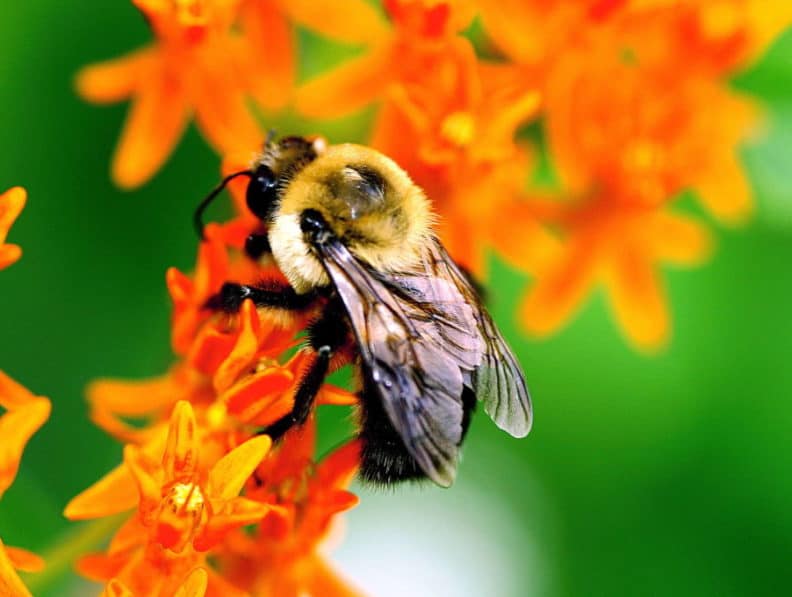
Takin’ Care of Beesinus: United States Native Bee Facts, Threats and Conservation
By Becky Moore, graduate student in the Institute’s 16th cohort.
Nearly everyone is familiar with the image and idea of a bee. The black and yellow character from Honey Nut Cheerios perhaps, happily making honey in buzzing hives. However, what most people do not realize is that there is a vast, diverse and complicated world of bees outside the classic honeybee, most of which goes largely unnoticed. In fact, there are over 20,000 species of bees worldwide, over 4,000 of which are found in North America. About 600 native species can be found in the state of Washington.
Our honeybee friend is actually not among these; this domesticated species was introduced to North America from Europe in 1640. The majority of native bees in the US are small, solitary species, most of which do not fit any of the classic images people may think of.
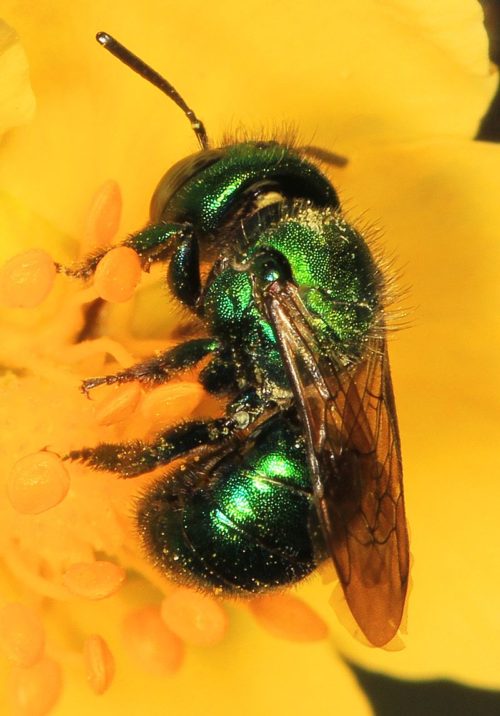
A beautiful metallic green bee (Augochloropsis metallica) visiting a flower. Image courtesy of WikiCommons
These bees have an average size of about 1cm long and live, nest, and feed completely on their own. Females forage to create enough provisions to feed their young, which they encase individually in carefully crafted cells. There are 5 major families of bees, each of which has their own methods of nesting. Some of these tiny solitary bees are miners, digging tunnels underground. Some are leafcutters, lining their nests with perfectly round leaf cutouts, some are masons, creating their nests out of mud and clay, and still others are carpenters, boring holes into wood to lay their eggs. Young bees hatch in the fall, hibernate over the winter, and emerge in spring to mate, begin foraging, and create their own nests, starting the cycle over. Many of these bee species are specialist feeders, meaning that they have co-evolved with specific species or families of flowers and are highly adapted to pollinate them the most effectively. Such plant species would not be able to survive without certain bee species.
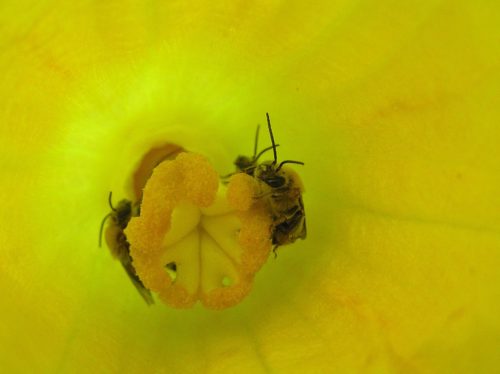
These tiny squash bees (Peponapis pruinosa) are an example of specialist foragers – they only feed on squash and pumpkin plants. Because of this, these bees are very important for the pollination of those crops. Image courtesy of WikiCommons
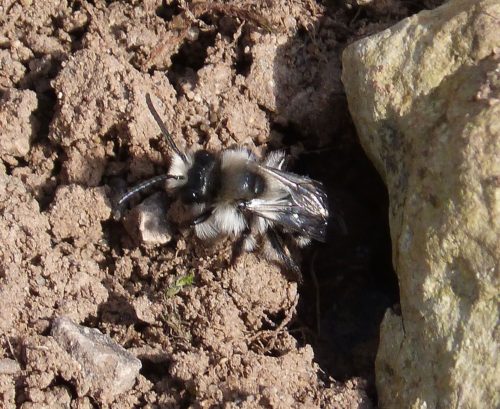
An ashy mining bee (Andrena cineraria) emerging from its nest underground. Image courtesy of WikiCommons
Bumblebees are the only native social bee in the US. They have many fascinating adaptations that allow them to live in colder climates and higher latitudes than any other bee species. They are also generalist feeders, meaning they will visit and pollinate a wide variety of plants. These characteristics make them particularly important pollinators in many different habitats. Honeybees, while not native, are also extremely important. The thousands of acres of monoculture crops across America are too much for native pollinators; these crops rely completely on the pollination services of the millions of honeybees that migrate annually across the nation on trucks with their beekeepers.
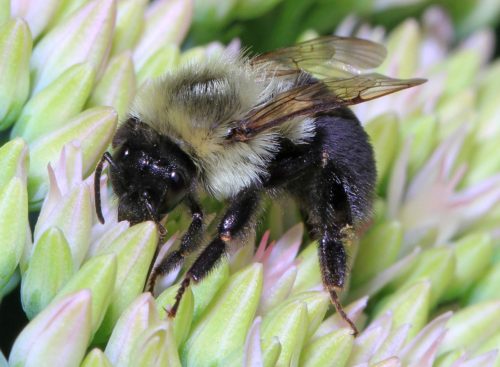
Common eastern bumblebee (Bombus impatiens) foraging. These bees are particularly important pollinators in their habitats. Image courtesy of WikiCommons
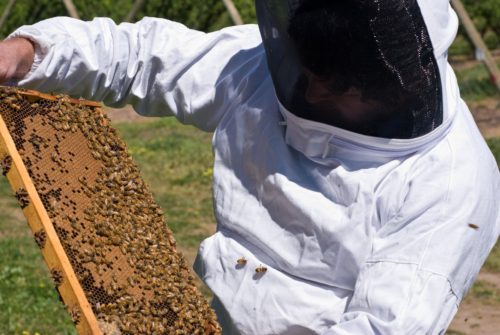
A beekeeper tending a European honeybee (Apis mellifera) hive. These domesticated bees typically cannot survive long without careful care from their keepers. A hive can contain up to 30,000 individuals. Image courtesy of WikiCommons
Bees certainly take care of business. 80% of the plants on the planet rely on bee pollination in order to survive. Because of this, bees are considered keystone species in nearly all terrestrial ecosystems. In addition, modern agriculture would not survive without honeybees. A third of the world’s food is produced through their services. And yet, bees all over the world are dying, by the thousands and millions. There are many reasons behind this, including habitat loss, insecticide use, and pests and disease.
The world needs bees. But bees are heading toward extinction, fast. In order to prevent the loss of a third of our food, the basis of global terrestrial ecosystems, and a huge portion of global diversity, humans need to start acting, faster. The bees need us. Organizations all over the world are beginning to take actions to try and learn more about these creatures so that they can be properly conserved and preserved.
What can you, the average citizen, do to help? Plant flowers! One of the biggest threats to bees is their lack of suitable habitat due to development and agriculture. Therefore, planting native, bee friendly flowers on your property is a simple, extremely useful way to help the bees. In addition, allowing pieces of your property to remain untouched, with tall grass tufts, leaves, and downed wood, is very important for providing nesting and hibernation habitat for bees. With a little effort, one can create a safe haven for native bees in their own backyard!
Bees humbly support the whole world on their tiny, fuzzy backs. Now, it is our turn to get down to business and help them. So please, go buy some seeds and get planting!
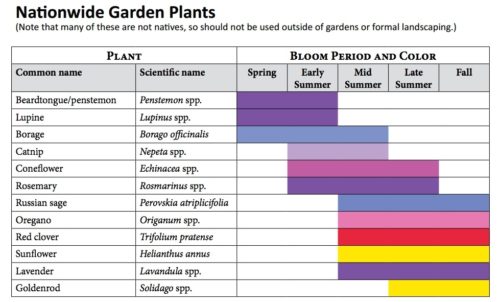
A chart showing common garden plants that are bee friendly. These plants are not invasive and have a variety of bloom colors, with bloom periods that range from early spring to late fall. All these characteristics are favorable when choosing which flowers to plant for a garden. Chart by Xerces Society
For more amazing and fascinating bee facts, as well as resources on threats, efforts being taken, and ways to help, please visit the Xerces Society and Pollinator Partnership.
Becky Moore is part of Cohort 16 and a M.Ed candidate through North Cascades Institute and Western Washington University. She grew up on the shores of Connecticut and her passions include skiing, hanging out with kids and ice cream.


I saw an ashy mining bee in Liberty Lake, Wa USA. I just thought I would share. I took a close up photo of it that is very clear. I believe it was a male because he had white tufts of hair on his bottom too. I had never seen one before
My dog found one this morning in Boulder Co